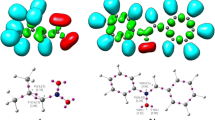Abstract
The effects of donor/acceptor substitution on the conrotatory cyclobutene/butadiene interconversion have not yet been experimentally studied. MNDO Synchronous Transit/MINIMAX calculations for all possible combinations of NH2/NH3 + 3 groups at the fissile single bond reveal very large substituent effects on the opening reactions and reverse cyclisations. Diamino(1b/2b), diammonio-(1c/2c) and amino-ammonio-substitutions (1d/2d) change the activation energy of the reference ring opening reaction (1a →2a) from 49.9 kcal/mol to 34.7, 29.8 and 26.0 kcal/mol, respectively. This rate enhancement parallels the monotone shift of the transition state pathcoordinate towards the cyclobutenes. Relative to the electrocyclic reactions1a/2a —1c/2c the calculated result for1d/2d is in opposition to the Hammond postulate, but a detailed analysis of the reaction paths suggests a mechanistic deviation in this kind of reaction. The calculated data for the reference process (1a/2a) and the oxetene isomerisation (3/4) when compared with available experimental data indicate that the MNDO calculations accurately reflect the experimental trends.
Similar content being viewed by others
References
Hoffmann, R., Woodward, R. B.: Die Erhaltung der Orbital-Symmetrie. Weinheim: Verlag. Chemie 1969
Review: Fleming, I.: Frontier orbitals and organic chemical reactions. London: Wiley, 1976
Cooper, W., Walters, W. D.: J. Am. Chem. Soc.80, 4220 (1958)
Freedman, H. H., Doorakian, G. A., Doorakian, G. A., Sandel, V. R.: J. Am. Chem. Soc.87, 3019 (1965)
Klumpp, G. W.: Reaktivitaet in der organischen Chemie, Bd. II. Stuttgart: G. Thieme Verlag 1978; and literature cited therein
Huisgen, R.: Angew. Chem.92, 979 (1980);
Taylor, E. C., Turchi, I. C.: Chem. Rev.79, 181 (1979)
Friedrich, L. E., Schuster, G. B.: J. Am. Chem. Soc.93, 4602 (1971)
Fieser, L., Fieser, M.: Organische Chemie, 2nd ed., p. 1450. Weinheim: Verlag Chemie 1972
Althoff, H., Bornowski, B., Daehne, S.: J. Pract. Chem.319, 890 (1977);
Jutz, C., Wagner, R. M., Loebering, H. G.: Angew. Chem.86, 781 (1976);
Jutz, C., Wagner, R. M., Kraatz, A., Loebering, H.: Liebigs Ann. Chem. 874 (1975)
Jensen, A.: Dissertation planned at the J. Gutenberg Universitaet Mainz. The reason for these difficulties is that semiempirical calculations, based on the σ — π-separation cannot be satisfactorily parameterized for heteroatoms. Moreover, calculations of this type are limited to planar molecules and ring closure reactions only
Epiotis, N. D.: J. Am. Chem. Soc.95, 1200 (1973);
Epiotis, N. D.: Angew. Chem.86, 825 (1974)
Carpenter, B.: Tetrahedron34, 1877 (1978)
Hsu, K., Buenker, R. J., Peyerimhoff, S.: J. Am. Chem. Soc.93, 2117 (1971);94, 5639 (1972);
McIver, Jr., J. W., Kormornicki, A.: J. Am. Chem. Soc.94, 2625 (1972);
refer to 14a); d) refer to 14c)
Dewar, M. J. S., Thiel, W.: J. Am. Chem. Soc.99, 4907 (1977);
Dewar, M. J. S., McKee, M. L., Rzepa, H. S.: J. Chem. Soc.100, 3607 (1978);
Dewar, M. J. S., Thiel, W.: J. Am. Chem. Soc.100, 7499 (1978)
Jensen, A.: Theoret. Chim. Acta (Berl.)63, 269 (1983);
Halgren, T. A., Pepperberg, I. M., Lipscomb, W. N.: J. Am. Chem. Soc.97, 1248 (1975);
Halgren, T. A., Lipscomb, W. N.: Chem. Phys. Letters49, 225 (1977)
Joergensen, W. L. Salem, L.: The organic chemist’s book of orbitals. New York: Academic Press 1973
Kemister, G., Pross, A., Radom, L., Taft, R. W.: J. Comput. Chem.2, 470 (1981)
Steiner, E.: The determination and interpretation of molecular wave functions. Cambridge: University Press 1976
Mulliken, R. S.: J. Chem. Phys.23, 1833 (1955)
Author information
Authors and Affiliations
Rights and permissions
About this article
Cite this article
Jensen, A., Kunz, H. The electronic substituent influence on the thermally allowed electrocyclic interconversion cyclobutene/butadiene. A MNDO study. Theoret. Chim. Acta 65, 33–47 (1984). https://doi.org/10.1007/BF02427578
Received:
Issue Date:
DOI: https://doi.org/10.1007/BF02427578




